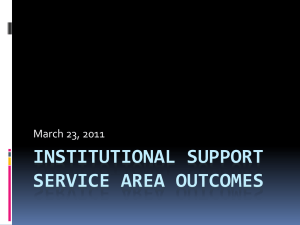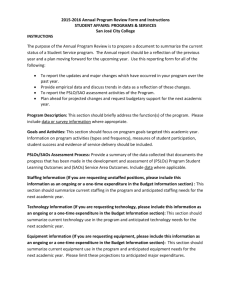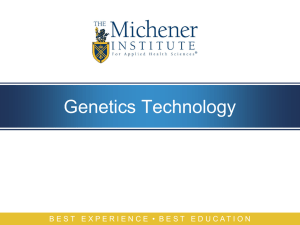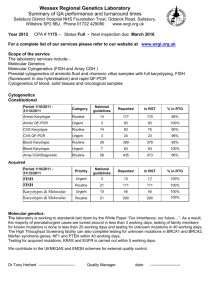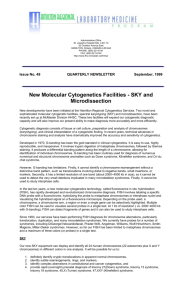HOKLAS SC-35
advertisement
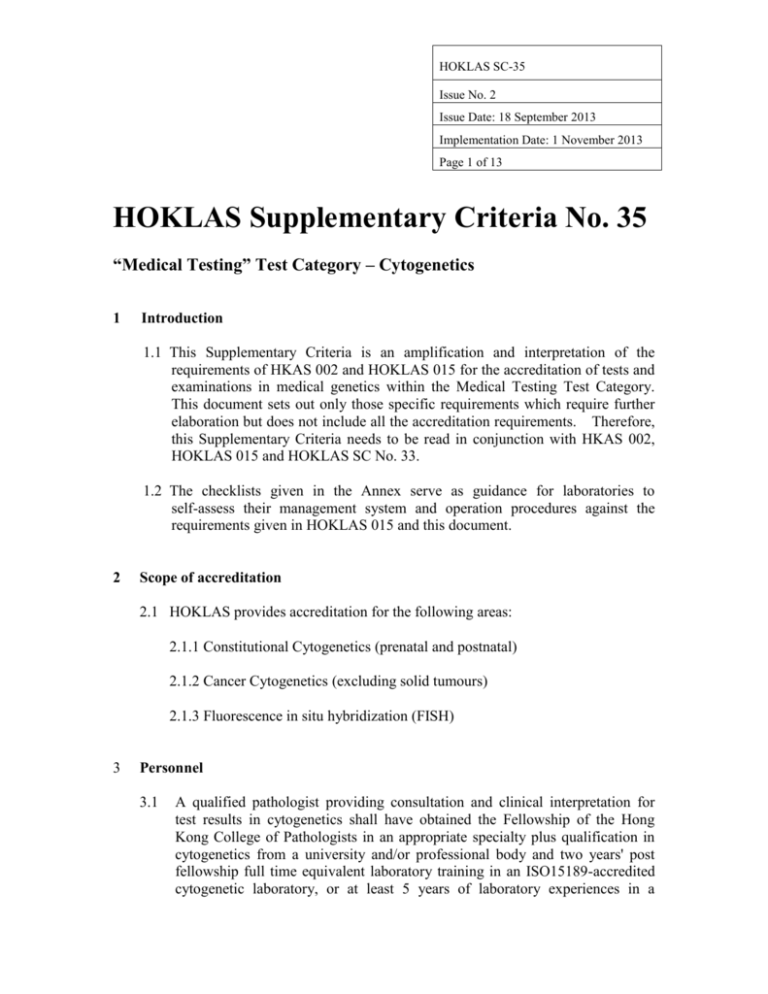
HOKLAS SC-35 Issue No. 2 Issue Date: 18 September 2013 Implementation Date: 1 November 2013 Page 1 of 13 HOKLAS Supplementary Criteria No. 35 “Medical Testing” Test Category – Cytogenetics 1 Introduction 1.1 This Supplementary Criteria is an amplification and interpretation of the requirements of HKAS 002 and HOKLAS 015 for the accreditation of tests and examinations in medical genetics within the Medical Testing Test Category. This document sets out only those specific requirements which require further elaboration but does not include all the accreditation requirements. Therefore, this Supplementary Criteria needs to be read in conjunction with HKAS 002, HOKLAS 015 and HOKLAS SC No. 33. 1.2 The checklists given in the Annex serve as guidance for laboratories to self-assess their management system and operation procedures against the requirements given in HOKLAS 015 and this document. 2 Scope of accreditation 2.1 HOKLAS provides accreditation for the following areas: 2.1.1 Constitutional Cytogenetics (prenatal and postnatal) 2.1.2 Cancer Cytogenetics (excluding solid tumours) 2.1.3 Fluorescence in situ hybridization (FISH) 3 Personnel 3.1 A qualified pathologist providing consultation and clinical interpretation for test results in cytogenetics shall have obtained the Fellowship of the Hong Kong College of Pathologists in an appropriate specialty plus qualification in cytogenetics from a university and/or professional body and two years' post fellowship full time equivalent laboratory training in an ISO15189-accredited cytogenetic laboratory, or at least 5 years of laboratory experiences in a HOKLAS SC-35 Issue No. 2 Issue Date: 18 September 2013 Implementation Date: 1 November 2013 Page 2 of 13 cytogenetic laboratory before 1 September 2008 (the launching date of HOKLAS for the accreditation of tests and examinations in Medical Genetics). 4 3.2 A medically qualified person providing consultation and clinical interpretation for test results in constitutional cytogenetics shall have obtained Fellowship in an appropriate specialty (e.g. Obstetrics & Gynaecology, Paediatrics) plus qualification in cytogenetics from a university and/or professional body and two years' post fellowship full time equivalent laboratory training in an accredited constitutional cytogenetic laboratory, or at least 5 years of laboratory experiences in a constitutional cytogenetic laboratory before 1 September 2008. 3.3 A biomedical scientist reporting test results in constitutional cytogenetics without clinical interpretation shall be MLT Board Part I registered (or exempted from such registration) and have obtained a BSc degree or above in a relevant subject plus 5 years of post-Part I registration supervisory experience in constitutional cytogenetics, or have obtained a recognised overseas qualification in cytogenetics. Laboratory equipment 4.1 Procedures to assure and verify the proper functioning of equipment shall meet acceptable professional standards, e.g. 4.1.1 Tissue culture incubators shall have a system to monitor the temperature continuously, and an alarm system to alert laboratory staff of abnormal culture conditions. 5 Pre-examination procedures 5.1 Both the request forms and specimens submitted for cytogenetic studies shall each contain at least two independent identifiers for unique identification of the patient. The identifying information on the request form shall be identical to that on the specimen tube label. There shall be a system to identify the person collecting the specimen for such tests. HOKLAS SC-35 Issue No. 2 Issue Date: 18 September 2013 Implementation Date: 1 November 2013 Page 3 of 13 6 7 8 Examination procedures 6.1 Each prenatal specimen for cytogenetic studies shall be divided, cultured in two separate incubators and maintained with independent cell cultures, media and reagents. Duplicate or independently established cultures should be included if adequate specimen is available. 6.2 For cytogenetic studies, adequate number of banded metaphases should be examined. In general, a minimum of 5 cells (10 for cancer cytogenetics) should be analysed, and at least two cells shall be checked by a qualified personnel as defined in clause 3.1 to 3.3. When there is evidence of mosaicism or clonal evolution, further cells should be examined. 6.3 For FISH studies, an effort should be made to examine a few metaphases with reverse DAPI chromosome staining to confirm that the correct probes have been used and to identify any unusual signal pattern. If metaphase is absent or inherent control signal is not available, the test should be repeated in parallel with another sample known to have the target of the probes. 6.4 There shall be a clear and consistent definition of fluorescence signals and also criteria for false positive and false negative signals. 6.5 Adequate number of interphase nuclei or metaphases should be examined. In general, a minimum of 5 metaphases and/or 100 interphase nuclei should be studied and scored. FISH signals shall be scored independently by 2 people. Assuring the quality of examination procedures 7.1 For tests that give quantitative results, the laboratory shall make an effort to estimate the uncertainty of measurement and document the uncertainty components. An example of such tests is FISH study with quantitative results. 7.2 All staff taking part in the testing activities shall participate in appropriate external quality assessments or interlaboratory comparison programmes. Post-examination procedures 8.1 A minimum of two karyotypes/images shall be prepared and archived. HOKLAS SC-35 Issue No. 2 Issue Date: 18 September 2013 Implementation Date: 1 November 2013 Page 4 of 13 8.2 9 Storage of the primary specimen and other laboratory samples shall be in accordance with the requirements given in Table 1. Laboratories should retain records and/or materials for a longer period of time than specified when such is appropriate for patient care, education, quality improvement needs or legal requirements, etc. Reporting of results 9.1 The description of test results shall follow the latest version of the International System for Human Cytogenetics Nomenclature (ISCN). For cancer cytogenetics and FISH studies in Haematology, the tests shall be reported by a qualified haematologist with appropriate training and laboratory experience. 9.2 For FISH studies in Anatomical Pathology, the tests shall be reported by a qualified anatomical pathologist with appropriate training and laboratory experience. 9.3 For constitutional cytogenetics, the tests shall be reported by a medically qualified person with appropriate training and laboratory experience as required in section 3.1 and 3.2. For those tests with normal results, numerical autosomal or sex chromosome abnormalities of well-recognised syndromes and common chromosomal polymorphism (an indicative list is given in Appendix 1), they may be reported by a biomedical scientist. To ensure that the test results on such reports would not be misinterpreted, the following mandatory remark shall also be shown on each of these reports: "Test results shown on this report require clinical interpretation and comments by a qualified pathologist (or equivalent as advised by the Hong Kong College of Pathologists)." 9.4 The laboratory shall keep information of available genetic counselling service. 9.5 Where appropriate, the test report shall include a recommendation that the patient should obtain genetic counselling from a qualified healthcare professional. - End - HOKLAS SC-35 Issue No. 2 Issue Date: 18 September 2013 Implementation Date: 1 November 2013 Page 5 of 13 Table 1 Retention of Laboratory Records and Materials General Cytogenetics/Fluorescence in situ hybridization Record/material Requirement Records of employee signatures, initials, and identification codes 10 years Referring doctor's request 3 years after dispatch of final report. Indefinite for request form which contains clinical information not readily accessible in the patient’s notes but used in the interpretation of test result. Where the request form is used to record working notes or as a worksheet, it should be retained as part of the laboratory record. Copies of reports Indefinite Patient information/karyotypes Indefinite Slides 3 years after final report if photographic record kept; 5 years otherwise, unless degeneration evident Original specimen and container/wet specimen/tissue 1 month after reporting Fixed chromosome preparation (blood, bone marrow) Abnormal: indefinite Normal: 6 months Tissue culture/cell culture Cryopreserved, and indefinite when appropriate Diagnostic images (digitised or ngatives) Indefinite N.B.: Indefinite means without limit of time, but not less than 30 years. HOKLAS SC-35 Issue No. 2 Issue Date: 18 September 2013 Implementation Date: 1 November 2013 Page 6 of 13 Appendix 1 An indicative list of the numerical autosomal or sex chromosome abnormalities of well-recognised syndromes and common chromosomal polymorphism. A. Non-mosaic numerical abnormalities: 1. Down Syndrome 2. Turner Syndrome 3. Patau Syndrome 4. Edwards Syndrome 5. Klinefelter Syndrome 6. Triple X 7. XYY 8. Triploidy Syndrome B. Common chromosomal polymorphism: 1. Pericentric inversion of chromosome 9 SC-35 Annex: Checklist on compliance with HOKLAS requirements - Cytogenetics HOKLAS Requirement Clause (HOKLAS 015, 4th edition and relevant SC) Clause (HOKLAS 015, 5th edition and relevant SC) Page 7 of 13 Issue No. 2 *1 Y N NA Lab’s Document Reference or Remarks2 Please ensure that the General Checklist (HOKLAS 021) is also completed for each discipline. Discipline Specific Management Requirements Quality and technical records 4.13 Do laboratory records indicate the media used, culture conditions and incubation times for all preparations? 4.13.3 (d) 4.13 (e) ● Do laboratory records include the number of cells counted, analyzed microscopically and the cells from which photographic or digitalized karyotypes are prepared? 4.13.3 (d) 4.13 (h) ● Do laboratory records include an assessment of banding resolution to indicate whether metaphase analysis is satisfactory? 4.13.3 (d) 4.13 (h) ● Discipline Specific Technical Requirements Laboratory equipment 5.3 Does the laboratory have adequate number of image processing systems? 5.3.1 5.3.1.1 ● Are microscopes equipped for high-resolution cytogenetics analysis? 5.3.2 5.3.1.1 ● Note: 1. The assessor should concentrate on items marked with a ●; other items will be checked by the team leader. 2. Please put down the laboratory’s document reference(s) where there are descriptions or procedures related to the requirement. Assessment Team’s remarks / questions to be asked at the laboratory SC-35 Annex: Checklist on compliance with HOKLAS requirements - Cytogenetics Page 8 of 13 Issue No. 2 Clause (HOKLAS 015, 4th edition and relevant SC) Clause (HOKLAS 015, 5th edition and relevant SC) Are cell cultures manipulated under conditions that ensure sterility and protect staff? 5.3.2 5.2.6 ● Is there a class II biosafety cabinet that is certified annually in the laboratory? 5.3.2 5.3.1.5 ● Are incubators fitted with alarms or override systems that protect against malfunction of temperature and CO2 controls? SC35 4.1 SC35 4.1 ● Is the quality of optical image-capture system high enough to minimize image degradation? 5.3.2 5.3.1.2 ● Pre-examination procedures 5.4 Does the information provided on the request form include gender and date of birth which are important for interpretation of genetic testing results? 5.4.1 (e) 5.4.3 (a) ● Are there procedures to verify sample identity and integrity? 5.4.2 5.4.4.3 ● Are at least two unique identifiers provided in both the request forms and specimens submitted for cytogenetic studies SC35 5.1 SC35 5.1 ● Is there a system to ensure the person collecting the specimens for cytogenetics and FISH tests can be identified? SC35 5.1 SC35 5.1 ● HOKLAS Requirement *1 Y N NA Lab’s Document Reference or Remarks2 Note: 1. The assessor should concentrate on items marked with a ●; other items will be checked by the team leader. 2. Please put down the laboratory’s document reference(s) where there are descriptions or procedures related to the requirement. Assessment Team’s remarks / questions to be asked at the laboratory SC-35 Annex: Checklist on compliance with HOKLAS requirements - Cytogenetics HOKLAS Requirement Clause (HOKLAS 015, 4th edition and relevant SC) Clause (HOKLAS 015, 5th edition and relevant SC) Page 9 of 13 Issue No. 2 *1 Examination procedures 5.5 Is each lot of culture medium checked for sterility? 5.5.1 5.3.2.3 ● Are there independently established or duplicate cultures to backup against unexpected failures, unless the sample contains insufficient cells to do so? SC35 6.1 SC35 6.1 ● Are at least two cells checked by a qualified personnel? SC35 6.2 SC35 6.2 ● When there is evidence of mosaicism or clonal evolution, are further cells examined? SC35 6.2 SC35 6.2 ● Y N NA Lab’s Document Reference or Remarks2 ● Constitutional Cytogenetics Is prenatal specimen for cytogenetic studies divided, cultured in two separate incubators and maintained with independent cell cultures, media and reagents? 5.5.1 SC35 6.1 5.5.1.1 SC35 6.1 ● Are duplicate prenatal culture flasks or dishes harvested independently? 5.5.1 5.5.1.1 ● For prenatal cultures, are at least two independent cultures analyzed? 5.5.1 5.5.1.1 ● Are the band level, quality of banding and resolution sufficient to render the reported interpretation? 5.5.1 5.5.1.1 ● Note: 1. The assessor should concentrate on items marked with a ●; other items will be checked by the team leader. 2. Please put down the laboratory’s document reference(s) where there are descriptions or procedures related to the requirement. Assessment Team’s remarks / questions to be asked at the laboratory SC-35 Annex: Checklist on compliance with HOKLAS requirements - Cytogenetics HOKLAS Requirement Are at least 5 cells counted? Clause (HOKLAS 015, 4th edition and relevant SC) Clause (HOKLAS 015, 5th edition and relevant SC) 5.5.1 5.5.1.1 Page 10 of 13 Issue No. 2 *1 Y N NA Lab’s Document Reference or Remarks2 ● SC35 6.2 SC35 6.2 SC35 6.2 ● Are culture methods, culture media and additives selected according to the nature of neoplastic disorder under study? 5.5.1 5.5.1.1 ● Are at least 10 cells analyzed, if possible? 5.5.1 SC35 6.2 5.5.1.1 SC35 6.2 ● Are at least 2 karyotypes per mainline and 1 karyotype each from pertinent sidelines generated for each case? 5.5.1 5.5.1.1 ● Has the laboratory established the reference range(s) for each probe used? 5.5.2 5.5.2 ● Are metaphases with DAPI chromosome staining to confirm that the correct probes have been used and identify any unusual signal pattern? SC35 6.3 SC35 6.3 ● If metaphase is absent or inherent control signal is not available in FISH studies, is the test repeated in parallel with another sample know to have the probe target? SC35 6.3 SC35 6.3 ● Are there a clear and consistent definition of fluorescence signals and also criteria for positive and false negative signals? SC35 6.4 SC35 6.4 ● Are at least 5 cells analyzed? Cancer Cytogenetics FISH analysis Note: 1. The assessor should concentrate on items marked with a ●; other items will be checked by the team leader. 2. Please put down the laboratory’s document reference(s) where there are descriptions or procedures related to the requirement. Assessment Team’s remarks / questions to be asked at the laboratory SC-35 Annex: Checklist on compliance with HOKLAS requirements - Cytogenetics Page 11 of 13 Issue No. 2 Clause (HOKLAS 015, 4th edition and relevant SC) Clause (HOKLAS 015, 5th edition and relevant SC) Are at least 5 metaphases and/or 100 interphase nuclei studied and scored? SC35 6.5 SC35 6.5 ● Are FISH signals scored independently by 2 people? SC35 6.5 SC35 6.5 ● If breakage studies are performed, are they performed with concurrent controls in the same manner as patient specimen? 5.5.1 5.6.2.2 ● Post-examination procedures 5.7 Are at least two karyotypes/images prepared and archived? SC35 8.1 SC35 8.1 ● Are fixed preparations of chromosomes and cells stored indefinitely if abnormal, and for 6 months if normal? SC35 Table 1 SC35 Table 1 ● Are slides stored for 3 years after final report if photographic record kept, or 5 years otherwise, unless degeneration is evident? SC35 Table 1 SC35 Table 1 ● Are negatives, prints or retrievable electronic media stored indefinitely? SC35 Table 1 SC35 Table 1 ● Are copies of reports stored indefinitely? SC35 Table 1 SC35 Table 1 ● Is original specimen and container/wet specimen/tissue stored one month after reporting? SC35 Table 1 SC35 Table 1 ● HOKLAS Requirement *1 Y N NA Lab’s Document Reference or Remarks2 Chromosome instability syndromes analysis Note: 1. The assessor should concentrate on items marked with a ●; other items will be checked by the team leader. 2. Please put down the laboratory’s document reference(s) where there are descriptions or procedures related to the requirement. Assessment Team’s remarks / questions to be asked at the laboratory SC-35 Annex: Checklist on compliance with HOKLAS requirements - Cytogenetics Page 12 of 13 Issue No. 2 Clause (HOKLAS 015, 4th edition and relevant SC) Clause (HOKLAS 015, 5th edition and relevant SC) Is harvested tissue culture/cell culture stored indefinite when appropriate? SC35 Table 1 SC35 Table 1 ● Reporting of results 5.8 HOKLAS Requirement *1 Y N NA Lab’s Document Reference or Remarks2 Does the cytogenetics report contain: - biological sex of the patient? 5.8.3 5.8.3 ● - description of specimen / tissue studied? 5.8.3 5.8.3 ● - number of cells (metaphases) analyzed, counted and karyotyped? 5.8.3 5.8.3 ● - banding method(s) used? 5.8.3 5.8.3 ● - diagnosis and classification according to the WHO classification (for haematology malignancies)? 5.8.4 N/A ● Is the current International System for Human Cytogenetics Nomenclature (ISCN) used correctly in the final report for conventional cytogenetic studies? SC35 9.1 SC35 9.1 ● Does the FISH report include information on the limitations of the test applied, on the source of the probe and on the implications of the result? 5.8.3 5.8.1 ● Is the final report for constitutional cytogenetics reported by a medically qualified person with appropriate training and laboratory experience as required in SC35 Clause 3.1 and 3.2? SC35 9.3 SC35 9.3 ● Note: 1. The assessor should concentrate on items marked with a ●; other items will be checked by the team leader. 2. Please put down the laboratory’s document reference(s) where there are descriptions or procedures related to the requirement. Assessment Team’s remarks / questions to be asked at the laboratory SC-35 Annex: Checklist on compliance with HOKLAS requirements - Cytogenetics Page 13 of 13 Issue No. 2 Clause (HOKLAS 015, 4th edition and relevant SC) Clause (HOKLAS 015, 5th edition and relevant SC) Do all reports specified in Clause 9.3 reported by a biomedical scientist show the following mandatory remark: "Test results shown on this report require clinical interpretation and comments by a qualified pathologist (or equivalent as advised by the Hong Kong College of Pathologists)”? SC35 9.4 SC35 9.3 ● Are appropriate genetics counselling referrals available for genetic testing and have these been documented in the laboratory’s procedures? SC35 9.5 SC35 9.4 ● HOKLAS Requirement *1 Y N NA Lab’s Document Reference or Remarks2 Note: 1. The assessor should concentrate on items marked with a ●; other items will be checked by the team leader. 2. Please put down the laboratory’s document reference(s) where there are descriptions or procedures related to the requirement. Assessment Team’s remarks / questions to be asked at the laboratory
